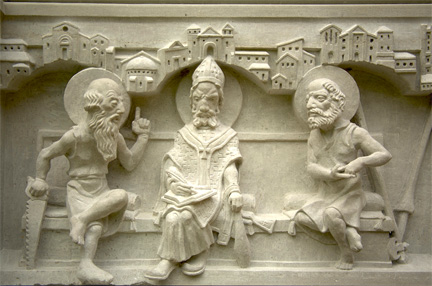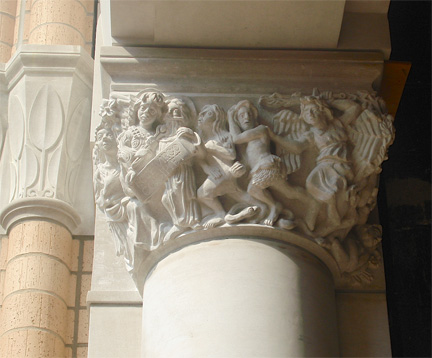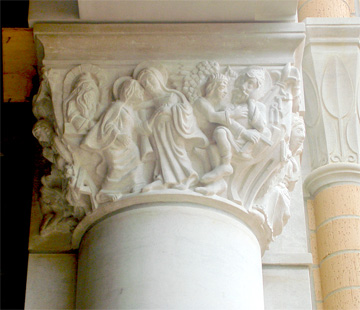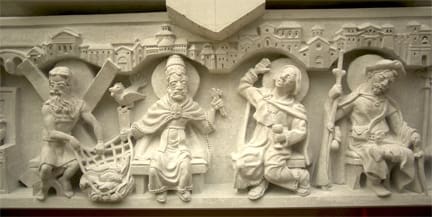Online Edition:
November 2013
Vol. XIX, No. 8
The Very Stones Shall Speak – Sculpture for the Chapel of Clear Creek Abbey
by Helen Hull Hitchcock
Andrew Wilson Smith is a freelance sculptor and stone carver who recently completed sculptures for the main portal of the chapel of Our Lady of the Annunciation Abbey at Clear Creek, Oklahoma.
Working in a variety of media including cast bronze, plaster, and stone, Mr. Smith has completed a number of sculpture commissions in both sacred and secular settings. Before embarking on his professional career, Smith served apprenticeships with sculptors Alexander Stoddart and Anthony Visco. Smith also attended the Pennsylvania Academy of the Fine Arts, as well as the Florence Academy of Art. During his studies, Smith honed his technical skills and developed a historical perspective on art and aesthetics that continues to guide his work.
The abbey buildings were designed by his father, the noted architect Thomas Gordon Smith, who has contributed articles to The Adoremus Bulletin.
We interviewed Mr. Smith about his interesting approach to the heritage of sacred art and architecture in his contemporary sculpture for the Clear Creek Abbey Chapel portal. (Photos by Andrew Smith.)
***
Adoremus Bulletin: Tell us a bit about the abbey in rural Oklahoma where your sculpture is located.
Andrew Smith: Our Lady of the Annunciation Abbey at Clear Creek, Oklahoma — most often simply called Clear Creek Abbey — was founded as a monastery in 1999 by a combination of American and French Benedictine monks from the Abbey of Fontgombault, France. It is a member of the Solesmes Congregation, which numbers 760 monks in 31 monasteries, mostly in Europe.
The abbey gained independent status in 2010, and elected its first abbot, Dom Philip Anderson, OSB — a native of Kansas who received his formation as a monk in France. Father Abbot sums up the abbey’s way of life in this way: “We just follow the old monastic life. We pray, worship and do manual labor and give counseling to people… People look to this monastery as a new beginning, as a new element that has a solid backing in a long tradition of monastic life.”
AB: What can you tell us about your sculptures at Clear Creek Abbey?
Smith: I have most recently completed a stone sculpture decorating the lintel of the great portal. The work consists of twelve figures representing the Apostles Simon, James the Less, Jude, Thomas, Andrew, Peter, John, James the Greater, Matthew, Jude, Philip, and Bartholomew (Nathaniel) carved into the lintel above the portal.
Earlier I had completed two stone capitals that narrate the biblical events surrounding the mystery of the Annunciation for the columns flanking the portal.
AB: What material did you use to sculpt these figures?
Smith: The stone slab comprising the lintel is 10 feet wide and 20 inches tall, and weighs roughly 13 tons. The Arkansas stone, known as “Batesville marble,” is more properly understood in geological terms as a dense limestone. The tight grain of the stone allows it to accept the carving of fine detail and its characteristics of durability and internal strength enable the high relief method of carving that I employed in the project.
Before the actual carving in stone, I made life-sized plaster models, which I used as a guide. During these projects, I worked from a studio that I set up at the abbey.
AB: Can you tell us how we can tell which apostle is which? There are no identifying labels in the carving.
Smith: Each apostle can be identified by one or more attributes, or objects, traditionally associated with a particular saint. For example, Saint James the Greater is shown in the guise of a pilgrim en route to the shrine of Santiago in Spain. He carries a staff and wears a sea shell in his hat, the symbol of baptism. The other apostles are shown with the particular implements of their martyrdoms or other objects relating to their ministries according to tradition.
AB: What can you tell us about the significance of the capitals on top of the two columns on each side of the portal?
Smith: The “Annunciation capitals” are each carved out of a single stone block measuring 15 inches tall, 24 inches deep, and 40 inches wide. Each stone weighs roughly 700 pounds and functions by channeling the load of the stone above down to the ground through the two columns that they surmount. A total of 18 human figures and several animals are carved into the pair of capitals.
Clear Creek Abbey is named in honor of the Mystery of the Annunciation; the capitals are designed as a way for the faithful to meditate upon this mystery. They are called historiated capitals, because they illustrate a sequential narrative or history.
The narrative begins with the creation of Adam and Eve in the Garden of Eden; God the Father is depicted drawing Eve out of Adam’s side. The second scene depicts the expulsion of the first humans from paradise as a result of their sin. This forecasts the need for redemption, which will come through Christ’s death and resurrection.
The Prophet Isaiah occurs next in the narrative. He holds the scroll foretelling the virgin-birth of a Savior: Ecce Virgo Concipiet, or Behold, the Virgin will conceive … (and bear a son, and you shall call Him Emanuel).
The annunciation scene spans from one capital to the other with the Angel Gabriel on the left hand side and Our Lady on the right. This is the central event of the narrative and expresses the Catholic understanding of Mary as the New Eve, whose acceptance of God’s will paves the way for the redemption of mankind.
The right hand capital continues the narrative focusing on several New Testament events. In the “Dream of St. Joseph,” an angel counsels and encourages the saint, an act that parallels the annunciation. Following this is the “Visitation,” in which the Virgin Mary shares with her cousin Elizabeth the news of what has transpired. Concluding the narrative is a carving of the Nativity of Christ.
AB: How did you arrive at the design for the portal sculptures?
Smith: Working closely with the abbot, I established the iconographic scheme of carvings and developed an artistic idiom that was to guide the project. One of the great pleasures of working on this project was the opportunity to collaborate with my father. He and I are very sympathetic to one another’s aesthetic sensibilities. Working together, we were able to finalize the design of the portal in such a way as to optimize the interplay between the sculptural and architectural elements.
Inspiration for the iconographic arrangement of the Annunciation capitals originated in medieval and renaissance treatments of the same mystery — especially several of the Annunciation paintings by the Blessed Fra Angelico, including the altarpiece of the Annunciation in the Museo del Prado in Madrid. (If you look at this painting closely you can see the expulsion of Adam and Eve taking place in the background and a sculpted bust of the prophet Isaiah that is carved into Mary’s cloister.)
The placement of the Twelve Apostles on the lintel of a church portal has medieval precedents in the history of church architecture, especially in Romanesque churches throughout Europe. In the composition for the abbey, I posed the apostles in the timeless space of the Heavenly Jerusalem, which is represented in the medieval tradition by a register of churches forming archivolts above the apostle’s heads.
AB: What historical styles of sacred art did you draw from to create this work?
Smith: The architecture of the abbey church fits within the tradition of Romanesque architecture, and I agreed with the abbot that the carvings should reflect a certain reverence for Romanesque sculpture. However, rather than directly imitating a particular Romanesque style of carving, I chose to form a new idiom by fusing my own artistic instincts with what I perceive as the joyful nature of historical French examples. I utilized common features of Romanesque sculpture, such as horror-vacui (the abhorrence of vacant spaces in an artistic composition) and non-realist canons of pro- portion for human figures. All these things played a role in the formation of a consistent idiom.
AB: Now that your work on the abbey project is complete, what does the future hold for you?
Smith: As this new academic year gets underway, I am very proud to be one of the founding faculty members of a new Catholic boarding school for boys, Gregory the Great Academy. This past summer I moved my studio to our campus in eastern Pennsylvania where my position as artist in residence allows me to pursue further sculpture projects alongside my other passion, teaching.
I have also been invited to exhibit several pieces of work this November at the International Artists Forum in New York City. An annual event sponsored by the World Youth Alliance, the forum will showcase the work of artists from around the world and provide an opportunity for dialogue about the role that artists play in promoting the inherent dignity of all human beings.

Saints Andrew and Peter, holding their fishnet, Andrew with his cross, Peter in papal vestments, holding the key (note the cock crowing above the net; Saint John with a chalice; and Saint James the Greater with pilgrim’s staff and with a shell on his hat

Saint Simon with saw; Saint James the Less in bishop’s mitre, writing his epistle; Saint Jude

Expulsion of Adam and Eve

Visitation
***
More information about Andrew Wilson Smith may be found at: AndrewWilsonSmith.com
More information about Clear Creek Abbey may be found at: clearcreekmonks.org
More information about Gregory the Great Academy may be found at: gregorythegreatacademy.org
****
***
*



